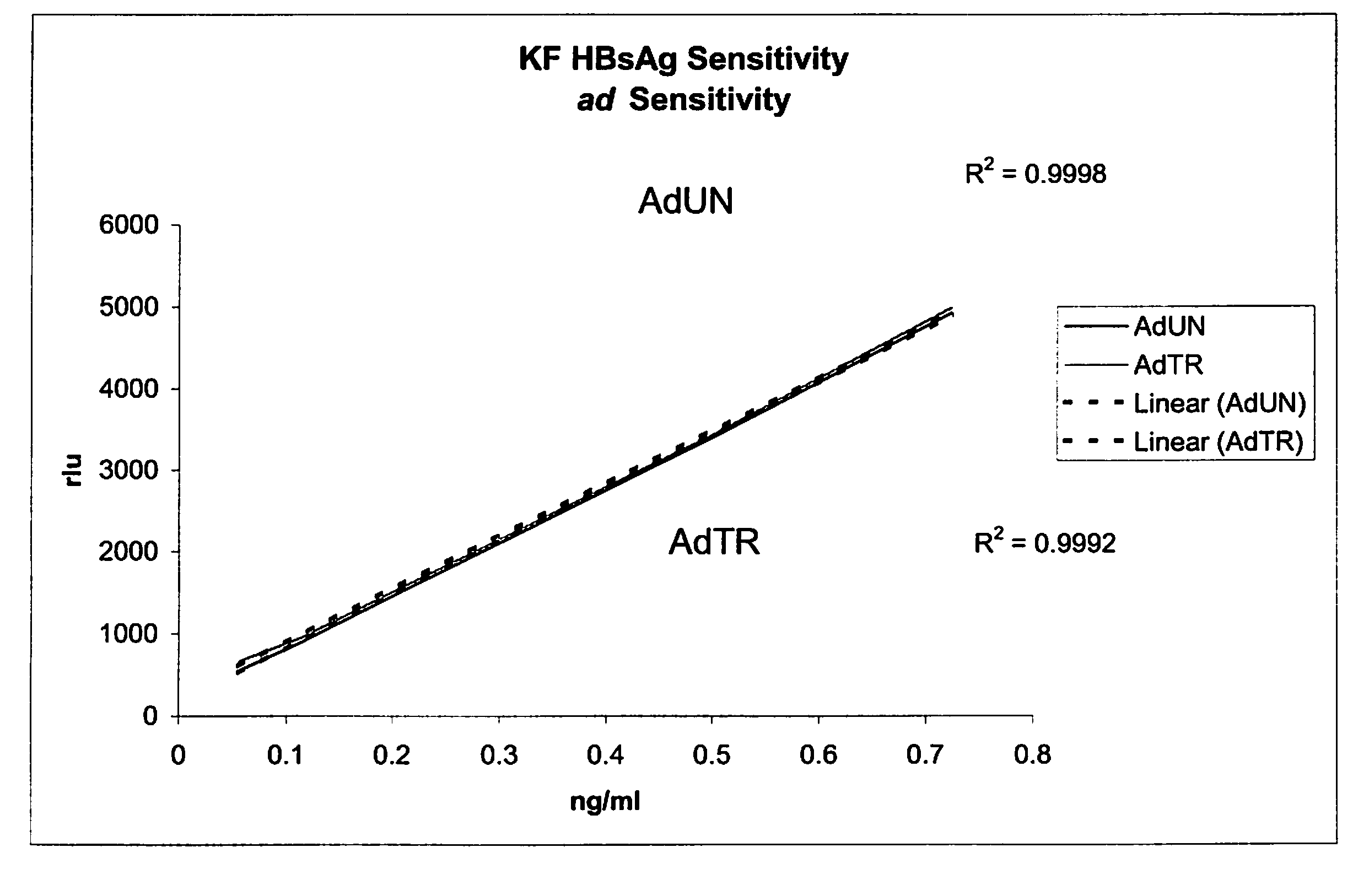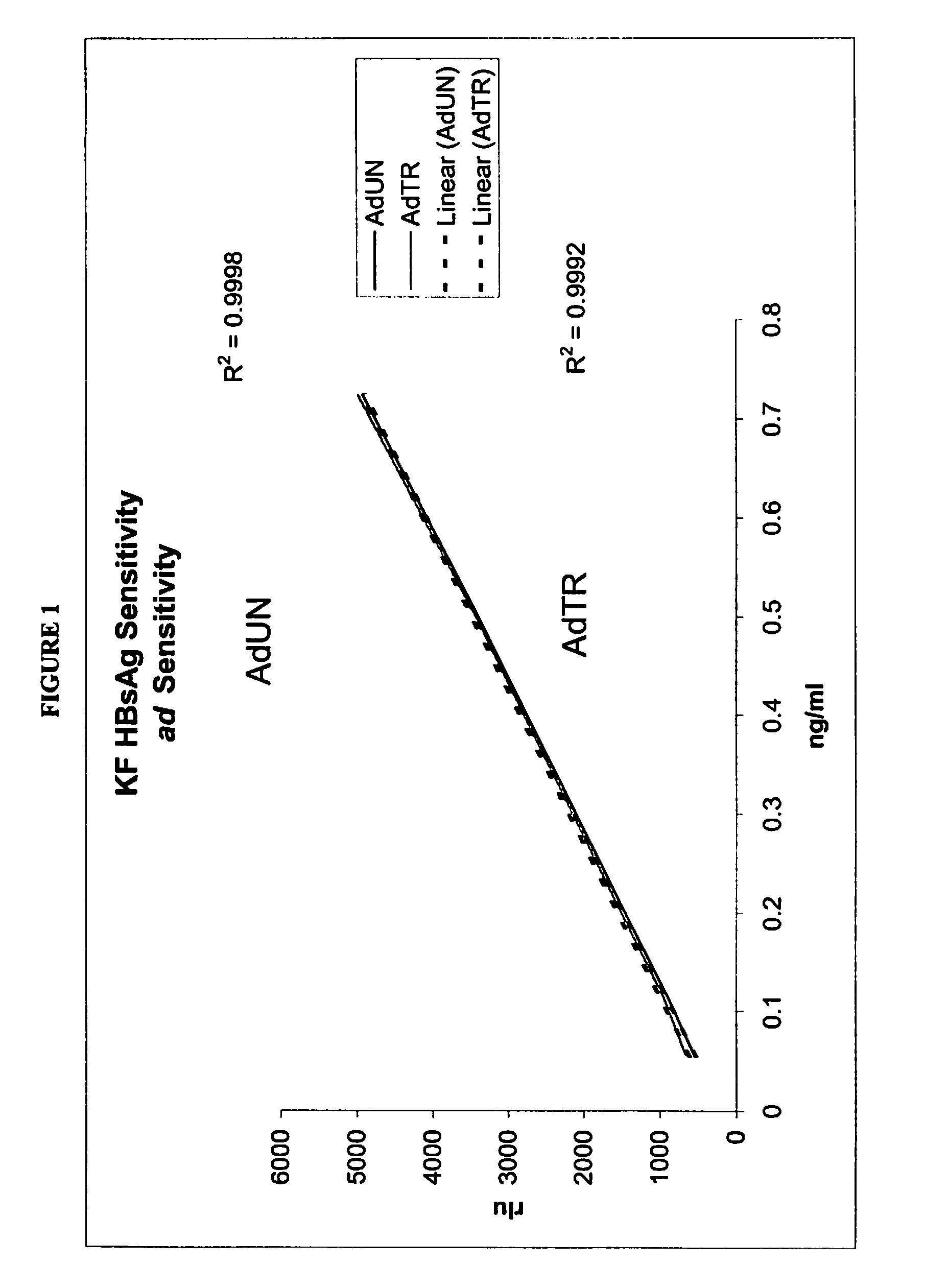Method for detecting a virus
a technology of viral target and detection method, which is applied in the field of increasing the sensitivity of viral target detection, can solve the problems of decreased sensitivity, non-specific binding, and high background level, and achieve the effect of reducing disulfide bonding
- Summary
- Abstract
- Description
- Claims
- Application Information
AI Technical Summary
Benefits of technology
Problems solved by technology
Method used
Image
Examples
example 1
Detecting Hepatitis B Surface Antigen Upon Displacing HBsAg / Anti-HBsAg Antibody Complexes Improves Detection of Samples with Immune Complexes
[0104]This example demonstrates that detecting a target protein upon disrupting target / antibody immune complexes improves the sensitivity of detecting the target in control immune complex samples. Immune complex samples were prepared by combining a sample containing anti-HBs with a solution of HBsAg (subtype ad) diluted to 150 pg / ml in normal human plasma. The amount of antibody in the immune complex samples was varied by diluting the anti-HBs sample by a factor of 10, 25, 50, 100, or 200 in the 150 pg / ml HBsAg solution. The mixture was incubated for at least 1 h at room temperature and then used in a prototype Abbott PRISM HBsAg assay (Abbott Laboratories, Abbott Park, Ill.) or stored at 4° C. The samples will serve as immune complex control samples to determine whether the signal is increased relative to treatment with low pH to dissociate im...
example 2
Increasing Sample Volumes and Detecting Hepatitis B Surface Antigen Upon Displacing HBsAg / Anti-HBsAg Antibody Complexes Improves Sensitivity and Detection of Samples with Potential Immune Complexes
[0112]This example demonstrates that detecting a target protein upon disrupting target / immune complexes increases the sensitivity of detecting the target and compares these results to previous testing. The general detection method of Example 1 was used to measure the level in treated and untreated samples. The treatment method to dissociate immune complexes is found in Table 6 and was used for all testing in this example. The sample volume used in the assay with immune complex dissociation was 250 μL. In the analysis of the immune dissociation test results, the level of signal measured from treated (displaced) and untreated (no displacement) samples containing HBsAg were compared to each other and also to their respective CO values.
[0113]The analytical sensitivity values of the assay using...
example 3
Detecting Hepatitis B Surface Antigen Upon Displacing HBsAg / Anti-HBsAg Antibody Complexes Improves Detection of Samples with Immune Complexes in a Magnetic Microparticle Assay
[0118]This example demonstrates that detecting a target protein upon disrupting target / antibody immune complexes improves the detection of target in samples that contain immune complexes in an assay format that utilizes magnetic microparticles and a KingFisher (KF) instrument. The KingFisher is a microtiter plate sample processor that moves magnetic microparticles from well to well of 96 well plates. There are 12 magnets that are covered with a disposable cover or tip comb. It is possible to release the microparticles into wells by withdrawing the magnet from the comb and to pick-up microparticles by inserting the magnet into the comb. Prior to processing samples on the KF instrument, sample and reagents are added to the plate. An instrument sequence was selected and the plate was processed on the KF. A total o...
PUM
| Property | Measurement | Unit |
|---|---|---|
| volume | aaaaa | aaaaa |
| volume | aaaaa | aaaaa |
| temperature | aaaaa | aaaaa |
Abstract
Description
Claims
Application Information
 Login to View More
Login to View More - R&D
- Intellectual Property
- Life Sciences
- Materials
- Tech Scout
- Unparalleled Data Quality
- Higher Quality Content
- 60% Fewer Hallucinations
Browse by: Latest US Patents, China's latest patents, Technical Efficacy Thesaurus, Application Domain, Technology Topic, Popular Technical Reports.
© 2025 PatSnap. All rights reserved.Legal|Privacy policy|Modern Slavery Act Transparency Statement|Sitemap|About US| Contact US: help@patsnap.com


